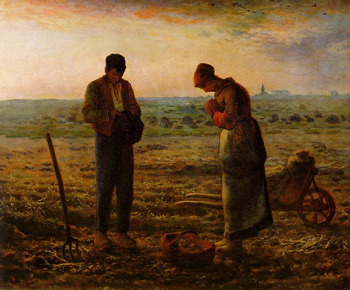
The Angelus

|
Jean-François Millet was a peasant first, an artist second. In his paintings, he rendered aspects of rural life as he saw them in his native region of Chailly, France,. He painted common scenes, but many of them were still of a celebratory nature: their everyday aspect belied the spiritual and emotional power Millet was able to imbue in them.
The Angelus is Millet's best-remembered work. It depicts a peasant man and woman, most likely a couple, at evening prayer time. The most striking aspect of the painting is the supple, gentle light that the setting sun bathes the land and figures in. Millet managed to capture a unique light, just before the late evening passes into dusk, and the subtle orange of the last light of the day fades and transitions to gray.
Beyond that though, the painting revolves around the separation and distinction of the man and the woman. At first glance, it appears that both, with their heads bent, are praying. Upon closer inspection, we can see that while the woman is praying, the man is in fact merely waiting for her to finish, his hands passively fiddling with his hat. Millet himself did not go to church, as was common in Chailly during his lifetime. This image is thus not a celebration of his own religious feeling, but a reflection of the realities of his life, and a simple statement that, in rural life, women's place is associated with the religious.
The man and woman are further separated by the light and the objects in the foreground. The light does not strike the man. It comes instead from behind him, striking the woman's front, separating and glorifying her, a reinforcement of her place as a spiritual person, and the man as less so. The man's side of the painting contains only a digging fork, a symbol of labor, and man's role as laborer in agricultural life. The woman's side, on the other hand, contains more objects, symbols of the gathering of fruits of labor for her family, underscoring her role as a household provider.
Echoes of The Angelus can be found in many subsequent works by Millet's contemporaries, a testament to its power and beauty.












